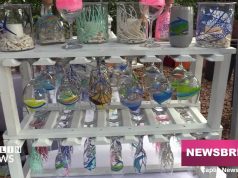Visitors at Miami’s Art Basel, which concluded this past weekend, might well have left thirsty if it weren’t for Argentine and Miami-based artist Agustina Woodgate’s sculpture, which included a water fountain, called “The Source.”
The sculpture was a part of the public exhibition “Disrupted,” which featured six installations by Argentine artists in Collins Park from Dec. 5 to 8.
“Providing free water and installing a set of drinking fountains in the park was almost like, ‘Why does that even have to be art?’” said Woodgate. “That should be a public service.”
The curators Florencia Battiti and Diana Wechsler, also from Argentina, selected exhibits that highlighted environmental and social aspects of Miami Beach.
Woodgate wanted to provide the public with water, but she also hoped to bring attention to the effects of climate change on one of South Florida’s water sources.
The sculpture consisted of four nine-foot pedestals made of concrete, keystone coral and Miami oolite, three kinds of rock that are commonly used in buildings throughout Miami Beach, Coral Gables and Homestead. The porous, sand-colored rocks made the water fountains look like Roman ruins.
Some people stared at Woodgate’s sculpture and frowned, unsure whether they were allowed to stand on its carved steps and drink the water.
Others immediately stepped on it to drink, not knowing the pedestals were part of a temporary exhibition.
Amber Foye of Philadelphia said that if she had not seen other sculptures around, she would have thought the pedestals were the park’s water fountains.
According to the U.S. Geological Survey, the Miami oolite and keystone corals are found under most of South Florida and form the Biscayne aquifer, an underground layer of porous rock and flowing water that is pumped out and used in spigots in Miami-Dade, Broward and Palm Beach counties.
The porous rock helps make the water safe to drink, but climate change increases sea level and creates an excess of salt.
When Woodgate was creating the sculpture, she understood the rocks’ role in making drinking water available to South Florida residents.
“Looking at Miami and what are the materials that are from here and what is the relationship of these materials to water,” she said. “The fountains, for me, would not make any sense if they were exactly the same but concrete.”
































